AMAZON multi-meters discounts AMAZON oscilloscope discounts
Articles / Guides:
Maintenance Engineering: Dust Collectors
CONTROLLING INDOOR AIR PROBLEMS: HOW TO KEEP THE BUILDING WORKING WELL -- part 1
CONTROLLING INDOOR AIR PROBLEMS: HOW TO KEEP THE BUILDING WORKING WELL -- part 2
- Indoor Air Quality -- from our series Fundamentals of Building Science
- Fundamentals of Woodshop Dust (and How to Control it)
- Ventilation: How to Create an Energy-Efficient Home
- Cheap vs. Expensive Furnace Filters
- Indoor Air Pollutants — Where to Find Them and What to Do
- Building Green and Indoor Air Quality:
- Wood Shop Dust Collectors
- Compressed-Air Systems
- Choosing a compressor
- Installing a compressed-air system
- Filtrating and regulating air
- Selecting Air Hoses
- Installing quick-release fittings
- Dehumidifiers
- Humidifiers
- Dust as a Fire Hazard
- Our Top Allergy-Fighting products
- Toxic Mold:
- Allergy-Fighting
Products
- Woodshop
Dust Control
- Safer
Indoor Air Using Air-Cleaning House Plants, Dust-Control Filters, and Other Methods
- Guide to choosing and using
masks and respirators
- Articles about Dust Control, Air Purifiers, Air Cleaners and Filters
Job Site and Landscaping
The Modern Home Workshop
Info on Air Cleaners:
Concern with health has caused air cleaners to become increasingly popular products in the US. According to the EPA, poor indoor air quality is among the top five environmental risks. Some say that pollutants in your home’s air can cause dizziness and headaches, and aggravate allergies and asthma. In order to make your home’s air free of pollutants, there are three steps you can take—remove the source of the problem, ventilate the area, or clean the air. Remember that air cleaning alone can't adequately remove all of the pollutants typically found in indoor air.
Also...
There are a few simple steps you can take to keep the air in your home healthy to breathe:
- Clean your home regularly
- Store chemicals in tightly sealed containers and dispose of any waste properly Control humidity and temperature
- Monitor your home’s air through air testing
- Hire an HVAC technician to make sure air-cleaning equipment and ducts are properly installed, sized, and sealed
Types of Air Cleaners:
There are a wide range of products available for helping to clean and regulate moisture levels in the air you breathe in your home. Unlike traditional air filters on your heating system, air cleaners are designed to filter out particles that are unseen by the human eye. These tiny particles are easily inhaled and are believed to cause or irritate health problems. Some air cleaners are designed to be installed in ducts as part of a central heating or air-conditioning system and others can be stand-alone units that are portable, working just in a concentrated area of the home.
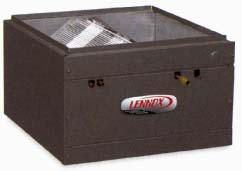
Above: Whole-house dehumidifier -- If excess
moisture is a problem in your home, you will benefit from ventilation and a dehumidifier. Shown here, the Humiditrol whole-home dehumidifier
system installs in the home’s existing duct system.
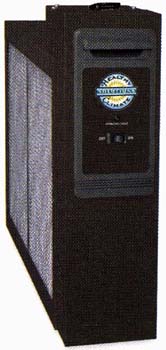
Above: Electronic air cleaner -- An electrical
field traps charged particles, preventing them from entering your
HVAC system. This air cleaner removes particles and bio-aerosols
down to 1 micron.
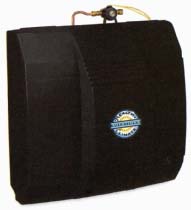
Above: Humidifier -- Indoor moisture levels
can be regulated by using a humidifier. This can enhance air quality and comfort. The model shown here works with most forced-air systems.
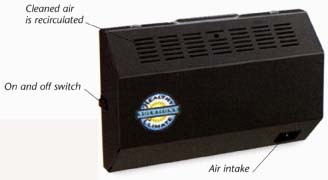
Above: Germicidal light -- One way to keep
air purified and surfaces clean and sterilized is with a germicidal
light. Using ultraviolet energy, it can quickly reduce concentrations
of airborne bio-aerosols.
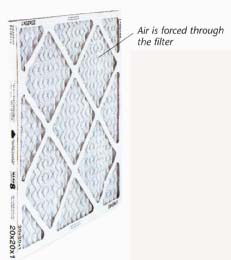
Above: Filter -- Air filters remove particles
from the HVAC system as new air circulates into the unit. This air
filter removes particles and bio-aerosols down to 3 microns, and is easy to replace.
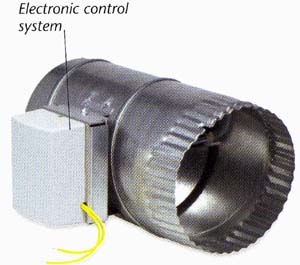
Above: Ventilation control system -- Gain
indoor air quality and increase comfort with a whole-house ventilation
system that automatically monitors the outdoor temperature and indoor
humidity levels.
FURTHER INFORMATION
Modern energy efficient windows, proper insulation, vapor barriers, and sealing all joints with caulk help reduce energy bills and increase the efficiency of a house. The problem is that a house functions best when it can still breathe. Houses need to be ventilated. Without proper ventilation in a home, moisture and mold can become a problem. For optimal comfort and health, experts say that the home’s relative humidity levels should range between 35 and 50%. By maintaining this humidity level, you may also be reducing the opportunity for mold and mildew problems.
Want to know more about why air cleaners are important health tools in today's polluted indoor-air environment? Read our article:
Safer Indoor Air: Using Effective, High-Quality Air Purifiers, Air Filtration and Dust Control
eBook for the Dust Control Industry Professionals | Indoor Air Quality/Dust Control resources (EPA links)